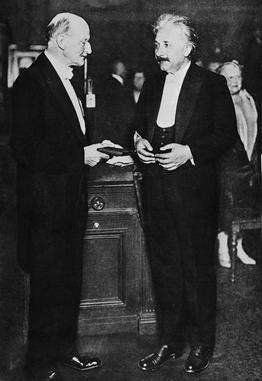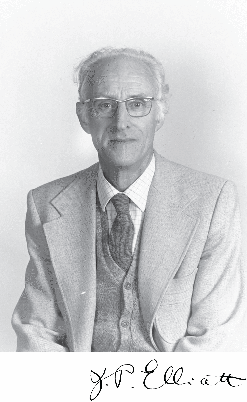Related Research Articles

Lise Meitner was an Austrian-Swedish physicist who was one of those responsible for the discovery of the element protactinium and nuclear fission. While working on radioactivity at the Kaiser Wilhelm Institute of Chemistry in Berlin, she discovered the radioactive isotope protactinium-231 in 1917. In 1938, Meitner and her nephew, the physicist Otto Robert Frisch, discovered nuclear fission. She was praised by Albert Einstein as the "German Marie Curie".

The Max Planck medal is the highest award of the German Physical Society (Deutsche Physikalische Gesellschaft), the world's largest organization of physicists, for extraordinary achievements in theoretical physics. The prize has been awarded annually since 1929, with few exceptions, and usually to a single person. The winner is awarded with a gold medal and hand-written parchment.

The ISOLDE Radioactive Ion Beam Facility, is an on-line isotope separator facility located at the centre of the CERN accelerator complex on the Franco-Swiss border. Created in 1964, the ISOLDE facility started delivering radioactive ion beams (RIBs) to users in 1967. Originally located at the Synchro-Cyclotron (SC) accelerator, the facility has been upgraded several times most notably in 1992 when the whole facility was moved to be connected to CERN's ProtonSynchroton Booster (PSB). ISOLDE is currently the longest-running facility in operation at CERN, with continuous developments of the facility and its experiments keeping ISOLDE at the forefront of science with RIBs. ISOLDE benefits a wide range of physics communities with applications covering nuclear, atomic, molecular and solid-state physics, but also biophysics and astrophysics, as well as high-precision experiments looking for physics beyond the Standard Model. The facility is operated by the ISOLDE Collaboration, comprising CERN and sixteen (mostly) European countries. As of 2019, close to 1,000 experimentalists around the world are coming to ISOLDE to perform typically 50 different experiments per year.
G. Norris Glasoe was an American nuclear physicist. He was a member of the Columbia University team which was the first in the United States to verify the European discovery of the nuclear fission of uranium via neutron bombardment. During World War II, he worked at the MIT Radiation Laboratory. He was a physicist and administrator at the Brookhaven National Laboratory.
Eugene Theodore Booth, Jr. was an American nuclear physicist. He was a member of the historic Columbia University team which made the first demonstration of nuclear fission in the United States. During the Manhattan Project, he worked on gaseous diffusion for isotope separation. He was the director of the design, construction, and operation project for the 385-Mev synchrocyclotron at the Nevis Laboratories, the scientific director of the SCALANT Research Center, and dean of graduate studies at Stevens Institute of Technology. Booth was the scientific director of the SCALANT Research Center, in Italy.
Gottfried Freiherr von Droste (1908–1992), a.k.a. Gottfried Freiherr von Droste zu Vischering-Padberg, was a German physical chemist. He worked at the Kaiser Wilhelm Institute for Chemistry (KWIC). He independently predicted that nuclear fission would release a large amount of energy. During World War II, he participated in the German nuclear energy project, also known as the Uranverein. In the latter years of the war, he worked at the Reich's University of Strassburg. After the war, he worked at the Physikalisch-Technische Bundesanstalt (Federal Physical and Technical Institute and also held a position at the Technical University of Braunschweig.
The Karl-Scheel-Preis is an award given annually by the Physikalische Gesellschaft zu Berlin, a regional association of the Deutsche Physikalische Gesellschaft, for outstanding scientific work. The prize was established through an endowment by the German physicist Karl Scheel and his wife Melida. Recipients are awarded with the Karl-Scheel Medal and 5.000 Euros. The Karl-Scheel Medal in bronze was designed by the German sculptor Richard Scheibe and has a diameter of 12 cm.
Klaus Blaum is a German physicist and director at the Max Planck Institute for Nuclear Physics in Heidelberg, Germany.

The Edison Volta Prize is awarded biennially by the European Physical Society (EPS) to individuals or groups of up to three people in recognition of outstanding achievements in physics. The award consists of a diploma, a medal, and 10,000 euros in prize money. The award has been established in 2012 by the Centro di Cultura Scientifica "Alessandro Volta", Edison S.p.A. and the European Physical Society.
The EPS CMD Europhysics Prize is awarded since 1975 by the Condensed Matter Division of the European Physical Society, in recognition of recent work by one or more individuals, for scientific excellence in the area of condensed matter physics. It is one of Europe’s most prestigious prizes in the field of condensed matter physics. Several laureates of the EPS CMD Europhysics Prize also received a Nobel Prize in Physics or Chemistry.

The Otto Hahn Prize is awarded biennially jointly by the Society of German Chemists, the German Physical Society and the city of Frankfurt am Main for outstanding achievement in the field of chemistry, physics or applied engineering science. It was established in 2005 by the merger of the previous Otto Hahn Prize for Chemistry and Physics and the Otto Hahn Prize of the City of Frankfurt am Main. The award is presented in the St. Paul's Church, Frankfurt am Main.

Nicola Ann Spaldin FRS is professor of materials science at ETH Zurich, known for her pioneering research on multiferroics.
The High Energy and Particle Physics Prize, established in 1989, is awarded every two years by the European Physical Society (EPS) for an outstanding contribution to high energy and particle physics. :) Enjoy

Johanna Barbara Stachel is a German nuclear physicist. She is a professor in experimental physics at the University of Heidelberg. Stachel is a former president of the German Physical Society (DPG).

James Philip "Phil" Elliott was a British theoretical nuclear physicist.
The Lise Meitner Lectures (LML) are a series of public lectures in honour of Lise Meitner. The lectures are organized jointly by the German Physical Society and the Austrian Physical Society, with the intention to showcase outstanding female scientists in physics or related fields. The annual lecture series was launched in 2008, when Lise Meitner's birthday celebrated its 130th anniversary. In October 2008, the Lise Meitner Lecture was held in Vienna and Berlin with an accompanying exhibition. The annual lecture series not only aims at increasing the visibility of successful female researchers, but also at encouraging girls and young women towards careers in physics.

Nuclear fission was discovered in December 1938 by chemists Otto Hahn and Fritz Strassmann and physicists Lise Meitner and Otto Robert Frisch. Fission is a nuclear reaction or radioactive decay process in which the nucleus of an atom splits into two or more smaller, lighter nuclei and often other particles. The fission process often produces gamma rays and releases a very large amount of energy, even by the energetic standards of radioactive decay. Scientists already knew about alpha decay and beta decay, but fission assumed great importance because the discovery that a nuclear chain reaction was possible led to the development of nuclear power and nuclear weapons. Hahn was awarded the 1944 Nobel Prize in Chemistry for the discovery of nuclear fission.
David Maurice Brink was an Australian-British nuclear physicist. He is known for the Axel-Brink hypothesis.
Peter John Twin is a British experimental nuclear physicist. He is known for his research into the structure of atomic nuclei, based upon his pioneering work on techniques of gamma ray spectroscopy and, specifically, the Total Energy Suppression Shield Array (TESSA).
Reinhard Stock is a German experimental physicist, specializing in heavy-ion physics.
References
- ↑ "EPS Nuclear Physics Division - Lise Meitner Prize". European Physical Society (EPS). 29 August 2018. Retrieved 5 October 2018.
- ↑ "2020 Lise Meitner Prize to Klaus Blaum, Björn Jonson, Piet Van Duppen". European Physical Society (EPS). 8 October 2020. Retrieved 10 November 2021.
- ↑ "2018 Lise Meitner Prize for Nuclear Science | e-EPS". www.epsnews.eu. Retrieved 2021-11-10.
- ↑ "Prof. Ulf-G. Meißner wins the 2016 EPS Lise Meitner Prize". European Physical Society (EPS). 17 May 2016. Retrieved 10 November 2021.
- ↑ "EPS Nuclear Physics Division: the Lise Meitner Prize 2014 is awarded". European Physical Society (EPS). 4 July 2014. Retrieved 10 November 2021.
- ↑ Evans, Tony (20 January 2009). "Obituary: Phil Elliott". The Guardian. Retrieved 5 October 2018.